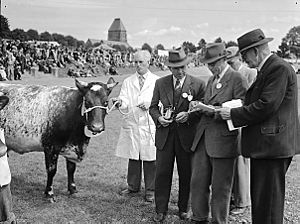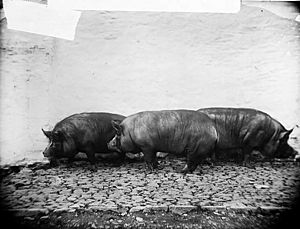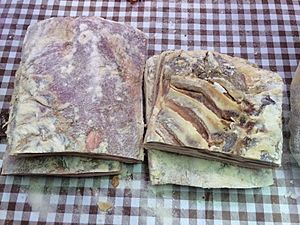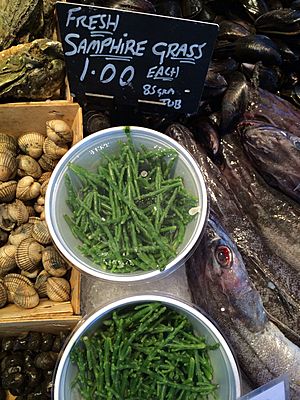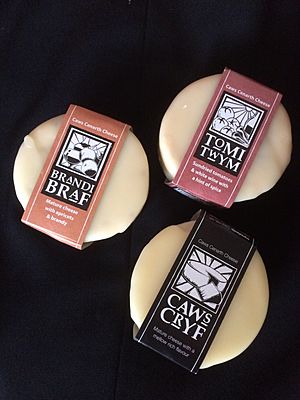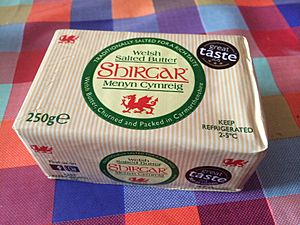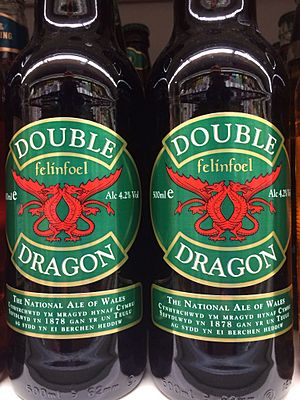Cuisine of Carmarthenshire facts for kids
Carmarthenshire, often called The Garden of Wales, is a beautiful county with rich farmland and busy seas. These natural resources provide a wide variety of foods that inspire many cooks and restaurants. The area has a long history of making beer, milling flour, gathering shellfish from the coast, and producing meat.
The Daily Telegraph newspaper has said that Carmarthenshire is a "worthwhile destination for foodies" because of its excellent food. Carmarthenshire hopes to become the top food-producing county in Wales. The Carmarthenshire County Council even has its own recipe book, Taste from Carmarthenshire, for those who want to learn more about the county's food.
Contents
Markets
Farming is a very important industry in Carmarthenshire. Many people visit the busy market towns across the county. Each market has a livestock sale on different days. For example, Llanybydder holds a regular market on Mondays and a horse sale once a month.
Carmarthen is the main town in the county. It has a full market on Wednesdays and Saturdays, but many stalls are open every day. This market is a great place to buy fresh local foods. The Carmarthen Market was part of a big redevelopment project finished in 2010. Llanelli market is another busy county market, with over 50 family-run businesses.
The farming year ends with the Carmarthen Agricultural Show in August. Another event, The Three Counties Show, also in August, displays many local products, from whiskey to chocolate.
Meat
Carmarthenshire's rolling hills are perfect for dairy and mixed farming. Both lamb and beef are very important here. Many farms specialize in producing beef from different types of cattle. Welsh Black beef has become more popular recently.
Several organic farms in the county are well-known. Fferm Tyllwyd in Felingwm Uchaf produces organic Welsh Black beef steaks. The May Organic Farms in Lampeter offer organic Highland beef and Welsh mountain lamb. Cig Calon Cymru in Cross Hands specializes in Welsh Black beef. They have a modern butchery connected to their own farms. Other quality suppliers include Dewi Roberts in Ffairfach, Llandeilo, and Cambrian Organics in Llandysul. Ystrad Traditional Organics in Brechfa produces lamb, hogget, mutton, and beef from some of Britain's rarest breeds.
Pigs are also a part of the mixed farming economy. In the past, every farm kept a Welsh pig for food. During winter, the main meat was cured ham and bacon from these pigs. Hams were cured in farm kitchen chimneys after being salted. This tradition has mostly faded, but some producers still make hams similar to those from Bayonne or Parma.
Carmarthen Ham is dry salt-cured and air-dried. It is sold whole or sliced thinly. People believe that when the Romans settled in Carmarthen, they learned the recipe and took it back to Italy, calling it Parma Ham. Carmarthen Ham is still made in small batches to keep it a special product. The Rees family at Carmarthen Market has been selling this ham for over 200 years. They were the first to commercially produce dry-cured ham in Britain. Carmarthen Ham is a favorite of the Prince of Wales.
Carmarthen Ham can be used in many recipes, like Country Ham with Vegetable Stew or Salad Paysanne with Carmarthen Ham and Lentils. It has even been featured on Rick Stein’s Food Heroes. In 2010, Carmarthenshire Ham was considered for special legal protection by the European Union. This would give it a special status, like Parma Ham.
Carmarthen Market also sells homemade brawn, sausages, pork pies, and faggots. You can find faggots fresh at Ettie Richardson's Home Baking stall. Brawn is a traditional Carmarthenshire dish. One recipe uses a pig's head and trotters, salted, washed, and then simmered for hours until the meat falls off the bone. The meat is then minced with onions, sage, and pepper.
Fets y Cybydd, or the Miser's Feast, was a popular dish in Carmarthenshire about 100 years ago. It's made in a saucepan or casserole. The bottom is covered with peeled potatoes and sliced onion, with a little salt and water. Once boiling, slices of bacon or ham are placed on top. The dish simmers until the potatoes are cooked and the water is gone. The "miser" would eat the potatoes one day and save the bacon for the next.
The poet Lynette Roberts wrote about making cawl in her poem Poem from Llanybri (1946). She mentioned serving a "choice bowl of cawl" with leeks.
Gilli Davies notes that not long ago, almost every meal in rural Wales included cawl. Fresh herbs, like winter savory, were grown nearby to add to the cawl. Only salted meat was available, and oatmeal was added to make the cawl go further. Sometimes, cooked oatcakes were crushed and added to reheated cawl for breakfast. In cold weather, cawl might be followed by apple or plain dumplings.
The Carmarthenshire County Council has created a Cawl Crawl. This is a special route that people can follow to try different versions of traditional cawl at various places in Carmarthenshire.
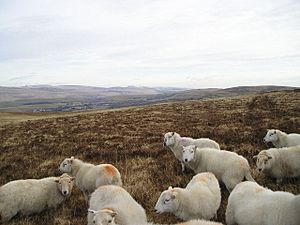
Fish
Carmarthen Bay stretches from Gower to Tenby. It's where Carmarthenshire's rivers meet the sea. These rivers, like the Towy, Teifi, Afon Cothi, and Taf, are excellent for fishing. The old way of coracle fishing can still be seen on the Teifi and Towy rivers.
Sewin is known as the prince of Welsh fish. It's a type of sea trout with pale, pinky flesh and a lot of oil. The fishing season for sewin starts around Easter and ends in summer. The largest fish usually swim up the rivers earliest. Sewin can range from small (called shiglin or twlpin) to very large (called gwencin), which can be as big as a salmon. You can tell a large sewin from a salmon by its tail, which is more indented, and its browny-grey color.
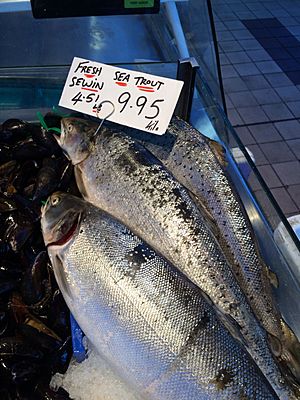
Raymond Rees at Carmarthen Market sells fresh fish from the coast and the Towy river. He specializes in sewin and is one of the few people licensed to fish with a coracle on the Towy. Sewin has a delicate flavor and is best cooked simply, like grilled or baked gently with salty Welsh butter. The butter brings out the flavor, and brown bread goes well with its smooth texture. To check if a sewin will taste good, ask the fishmonger to make a small cut in its back. The flesh should be a clear pink. If a sauce is used, fennel is a good herb to add, or cucumber sauce or samphire.
Sea food
Mussels are collected by hand from Carmarthen Bay. They are best in the winter months, when there's an 'R' in the month (September to April). Cockles are gathered in the Burry Inlet, mostly on the Gower side. However, Les Parsons from Laugharne started his own shellfish business on the Carmarthenshire side in 1947. This was when Dylan Thomas lived there and wrote about the "web-footed cocklewomen of Laugharne." Les Parsons experimented with bottling cockles in vinegar to sell them further away, creating Parson's Pickles. The company uses Laugharne Castle in its logo because the original factory was near the castle. Now, the company operates from Burry Port, producing cockles, mussels, and other pickles using traditional recipes.
Vegetables and fruit
Vegetables and fruit are grown in gardens and allotments. Lynette Roberts described a Carmarthenshire cottage garden where most of the space was for potatoes, broad beans, cabbage, and parsley. A smaller bed would have lettuce, carrots, leeks, and other small vegetables. This made families quite independent for their food.
Dylan Thomas also wrote about cottage gardens in Under Milk Wood. He described a garden with apple trees, blackcurrant bushes, beanrows, onion beds, and tomatoes.
In the past, cottage gardens were seen as a "chemist shop" because the vegetables, greens, and fruit grown there helped keep families healthy. Vegetables that could be stored for winter included leeks, parsley, cabbage, swedes, carrots, parsnips, potatoes, and nuts.
Larger Carmarthenshire houses often had walled kitchen gardens. These walls provided privacy and protected plants from frost. They often included greenhouses for delicate plants. Most of these gardens date from the 1800s. After World War I, many were left to grow wild. However, places like Aberglasney and Middleton (at the National Botanic Garden of Wales) have been restored and are now open to the public.
Families without a garden often grew fruit and vegetables on an allotment. Allotments started as a way to help feed the poor. Today, they are popular for improving mental and physical health, especially with the rise of the organic movement. The National Trust created 60 allotments in Llandeilo in 2009. In 2011, Carmarthenshire County Council noted that more people wanted allotments due to concerns about food origin and cost.
Garden vegetables were used to make cawl. Sometimes, cawl was made with just vegetables, called Cawl pen lletwad, when meat was scarce. If cawl needed to be made quickly, vegetables (and meat, if added) were cut into small pieces and boiled together. This was known as Cawl ffwt a berw.
Potatoes were a main garden vegetable, eaten roasted or boiled. One potato dish is Cig ar wyneb tato. This involves partly boiling potatoes in a heavy saucepan, then covering them with bacon and chopped onions or chives. It's cooked with a little water until the bacon fat browns the potatoes. This meal was often served with buttermilk.
Apples were an important food source. Many farms in the county have names that include perllan (orchard) or afallen (apple tree). Some old Welsh apple varieties have been rediscovered, like Marged Niclas. Local varieties were often used if imported ones didn't grow well in the wetter Welsh climate. The National Botanic Garden of Wales has an orchard of native apple trees. Old maps show many orchards in the Tywi valley. Apples were also used for medicine in the past.
Cheese
The Farmhouse Cheese Shop in Carmarthen Market is run by John and Patrice Savage-Ontswedder. They sell their own Teifi Cheeses and Glynhynod Caerphilly, along with many other cheeses made in West Wales.
Teifi Cheese is an organic cheese made from cow's milk. When it's young, it's bright yellow with a sweet, fruity taste. As it gets older, it becomes harder. It's similar to Gouda cheese and can be eaten alone or used in recipes.
The Savage-Ontswedders also make Celtic Promise. This is a soft cow's milk cheese with an orange-red rind. It's washed in cider during ripening, making it creamy, rich, and yellow with a strong smell and spicy taste. This cheese, along with another called Saval, has won awards at the British Cheese Awards. Celtic Promise goes well with cider, ale, and certain wines.
Llanboidy Cheese used to be made on an organic farm near Llanboidy. It was unique because it was made from the milk of Red Poll cows, a rare breed. This gave the cheese a fresh, grassy smell and a sharp taste.
Other Carmarthenshire cheeses include Caws Cenarth and Kid Me Not, both of which have won prizes. Caws Cenarth supplies its Perl Las blue organic cheese to places like England's Twickenham rugby stadium and even British Airways.
Condiments
Kite Wholefoods in Pontyberem makes organic mayonnaise. Pencae Mawr Farm Foods in Llanfynydd produces homemade chutneys, preserves, and other condiments. They have won awards, including a gold medal for their beetroot relish.
Cakes and sweets
Popty Bach-y-Wlad, which means little baker in the countryside, is a traditional bakery at Carmarthen Market. They bake Welsh Cakes, Bara Brith, teisen lap (Welsh plate cake), and various breads and buns. At Pobdy Stephens Bakehouse, also at Carmarthen Market, you can find Welsh cakes, sultana pancakes, and Victoria sponge cakes.
The Richardson family from Llansteffan has a stall in Carmarthen Market selling Etta's Royal Cake. This cake is a favorite of the Prince of Wales. It was even ordered by Queen Elizabeth II for the wedding reception of Prince Charles and Camilla.
Fiona's Fudge in Carmarthen makes homemade fruit cakes and fudge. In Llandovery, Just So Scrumpitious/O Mor Braf makes organic fudge, biscuits, and cakes without preservatives.
Mario’s Ice Cream, made by Mario Dalavalle, has won awards for being the best dairy ice cream in Great Britain. He makes 30 varieties at his dairy in Crosshands. All the milk comes from local farms. Mario believes people are willing to pay more for quality ice cream. Frank’s Ice Cream from Capel Hendre, Ammanford, has also won many national and European awards. Tregroes Waffle Bakery in Llandysul makes sweet waffles based on old recipes.
Brynderi Honey Farm in Whitland produces honey and packs organic honey from their own hives. They also make honey ice cream and marmalade.
Drink
Felinfoel Brewery Company in Felinfoel, Llanelli, is a traditional brewery known for its beer. It was founded in 1840 and invented canned beer in 1935. Their Double Dragon beer is sold in many countries. Evan Evans Brewery in Llandeilo makes an ale called Cwrw, which is Welsh for beer. The Towy Valley Cider Company in Carmarthen makes cider using apple juice pressed on the farm. It's aged in oak barrels for at least a year, making it a strong, clear cider.
Brecon Carreg is a natural spring water produced at Trap, Carmarthenshire. It comes in still or sparkling versions.
Other markets and box schemes
Other markets in the area include Ammanford street market (every Friday), Llandeilo open air market (every Friday), Carmarthen farmers’ market (first Friday of every month), Llandovery market (last Saturday of every month), and Ammanford farmers’ market (last Thursday of every month).
Carmarthen Showground hosts three large food and drink festivals each year: The Winter Show, The Spring Show, and The Summer Show. These events showcase the best local food, drinks, and crafts.
Box schemes are offered by companies like Organics to Go near Llandeilo, which delivers organic produce throughout South and West Wales. M & M Organics in Pontyberem also runs a box scheme in Carmarthenshire and Pembrokeshire. The Organic Pantry in Ammanford delivers food right to your door.
Images for kids


